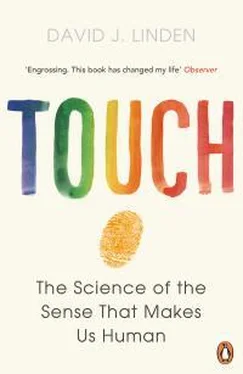Why is it that watching someone else’s finger being hit with a hammer will not usually make us withdraw our own fingers, but watching someone scratch will make us feel itchy and cause us to scratch as well? The best guess is as follows: Through most of our human history we have been routinely exposed to disease- and toxin-bearing parasites. In situations where these occur, if you notice that the person next to you is scratching, there is a good reason to believe that you are also being exposed to the same dangerous insect, worm, etc., and it’s therefore adaptive for you to feel itchy and scratch in order to reduce your own chance of harm. Pain, in contrast, is weakly socially contagious, because the cause of most pain is not generally spread from person to person.
Imagine that you are in a subway car and the person sitting next to you begins to scratch uncontrollably. That stranger is clearly tormented but—be honest now—is your first reaction compassion or revulsion? André Gide examines this question:
The itch from which I have suffered for months … has recently become unbearable and, for the last few nights, has almost completely kept me from sleeping. I think of Job looking for a piece of glass with which to scratch himself and of Flaubert, whose correspondence in the last part of his life speaks of similar itchings. I tell myself that each of us has his sufferings, and that it would be most unwise to long to change them; but I believe that a real pain would take less of my attention and would after all be more bearable. And, in the scale of sufferings, a real pain is something nobler, more august; the itch is a mean, unconfessable, ridiculous malady; one can pity someone who is suffering; someone who wants to scratch himself makes one laugh. 24
Unrelenting itch may indeed be the worst form of sensory torment. Perhaps Dante should have reserved it for the worst sinners in the innermost Circle of Hell. The compulsion to scratch is overwhelming, and yet when we do so, those around us recoil and regard us as doubly cursed: both infested and weak willed.

CHAPTER EIGHT
Illusion and Transcendence
The real tactile world is wonderfully messy and complicated. It’s not composed of easily separable touch stimuli—a little pain on the abdomen here, followed by a gentle caress on the arm there. In the early part of the twentieth century, psychologists studying perception began to recognize that many of the most important and motivating tactile sensations, such as wetness, greasiness, or stickiness, might not be basic touch senses with dedicated detectors in the skin, but rather what they came to call touch blends. These old scientific papers make for delightful reading. In experiments designed to explore the factors that result in a sensation of “clamminess,” M. J. Zigler of Princeton University used a series of increasingly creepy stimuli. Writing in 1923, he quoted an earlier researcher who claimed that a “horribly clammy feel is touched off when the finger is set upon by a bit of cold boiled potato in the dark.” In his own work he found that a cold boiled potato was insufficiently clammy, so he searched for a more effective touch stimulus, eventually settling on a damp kid glove filled with moistened oatmeal. Zigler concluded that clamminess is a blend of touch sensations, most notably coldness and yielding softness, and went on to state that “a genuine clammy experience” will always be perceived as unpleasant. 1
To study the perception of wetness through touch, I. M. Bentley of Cornell University first sought to eliminate the other senses. His subjects were blindfolded, and their ears and noses were stuffed with cotton. Their right hands were secured, palm down, with their extended middle fingers hanging over the edge of the table. Test liquids, consisting of mercury, petroleum, water, Eldorado oil 2, molasses, benzene, and ether were poured into a beaker, which was carefully raised, using a system of pulleys, to submerge the middle finger. Bentley argued, “The apprehension of wetness is commonly considered something unique: The finger touches a wet surface, or the hand is plunged into a liquid, or the body is immersed, and one is said just ‘to feel wet.’ This is a striking instance of the confusion of mental processes and their significance; in this case, a confusion of sensation with perception.” He concluded, after many pages, that the perception of wetness was likewise a touch blend, most strongly influenced by temperature and pressure. 3
Were Bentley and Zigler correct about the blended nature of the respective complex touch perceptions they studied, or should we expect that unique wetness- or clamminess- (or stickiness- or greasiness-) detecting molecules in dedicated sensory neurons will be found someday? The answer is almost certainly the former. Neither experiments on human perception, recordings of single sensory nerve fibers, nor molecular genetic studies are pointing to dedicated sensory neurons for these sensations.
You may be thinking that this consideration of the validity of the existence of touch blends is a straw man argument—after all, could we really have expected that there would be dedicated sensory neurons for sensations like wetness or clamminess? But we should be humbled by the lessons of our past experience. It is only very recently that we have obtained strong evidence for unique itch receptors, and it would have been reasonable before then to maintain that itch, too, is always experienced as a touch blend. That’s the fundamental power of biology: No amount of philosophical reasoning, linguistic analysis, or introspection could ever have resolved such matters.

So what have we learned about touch? Starting at the skin, we have an assortment of nerve endings ranging from bare nerves to specialized structures with wild and elaborate shapes. Each of these is a molecular machine fine-tuned by evolution to extract different aspects of information about our tactile world. The nerve fibers that relay the information from touch sensors in the skin to the spinal cord are mostly (but not entirely) dedicated to a single class of sensor for mechanical sensation: one tuned for rough texture, another for vibration, another for stretching. Surprisingly, we even have specialized sensors for caress, itch, and, quite likely, sexual touch. Some of these streams of information are conveyed by fast fibers, and some by slow ones, so they arrive at the brain with different delays. Most often, slowly transmitted information, like that from the caress sensors or the second wave of pain, activates the emotional-affective-cognitive portions of the brain’s touch circuits, while fast information, like that from traditional mechanosensors, activates sensory-discriminative centers. The streams of touch information from these various dedicated detectors are combined with signals about attention, emotional state, and past history so that by the time we have conscious access to touch sensation, it is in the form of a unified and useful percept with both discriminative and emotional properties.
Crucially, our brains are not passive recipients of touch information; rather, they can send descending signals to the spinal cord to turn the gain of touch signals up or down before they reach the brain. This has been most easily studied in the descending pain system, but is likely to be relevant for other aspects of touch as well. The touch circuits of the brain and spinal cord have been sculpted to solve particular evolutionary problems: how to find food, avoid danger, mate, protect offspring, etc. Indeed, all touch sensation (or sensation of any kind) is ultimately in the service of action. Our touch circuits are not built to be faithful reporters of the outside world but are constructed to make inferences about the tactile world based upon expectations—expectations derived from both the historical experience of our human ancestors and from our own individual experiences. And finally, we’ve learned that interpersonal touch not only has a special role in early human development but continues to be crucial across the span of human social life, promoting trust and cooperation and thereby deeply influencing our perceptions of others.
Читать дальше














